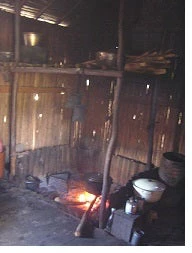
As incomes rise, the transition to modern energy sources will ultimately reduce HAP. During the transition, efforts to increase access to cleaner fuels, provision of improved stoves, and public information leading to improved ventilation and behavior change may significantly reduce exposure to household smoke. Design of HAP reduction strategies has been hindered, however, by a lack of data on air quality in households and the health benefits of potential mitigation measures.
To help fill these gaps, we (along with Hussain Samad) used new information from Madagascar on concentrations in household air of fine particles with diameter less than 2.5 microns (PM2.5) and carbon monoxide (CO), to analyze the effect of fuel type, stove type and ventilation on these sources of HAP. Our analysis drew on a collaboration between the World Bank and a team led by Practical Action Consulting, including the University of Liverpool, Berkeley Air Monitoring, Eco-consult and Project GAIA, in close co-operation with Fondation TanyMeva, Meres Diligentes, and Agence de Jeunes pour la Developpment à Vatomandry. From 2009-210, the team monitored indoor air in a sample of households in two towns in Madagascar: Ambositra (located in the central highlands), and Vatomandry (located on the central east coast). In selecting households for air monitoring, the focus was on the two most predominant types of fuel, charcoal and wood.
The Global Burden of Disease Study 2010 found that HAP is the second leading cause of disease in Madagascar, accounting for some 6.7% of the national burden of disease. More than 99 percent of households rely on solid biomass, such as charcoal, wood, and crop waste, as the main cooking fuel. Since cooking with clean fuels is rare in Madagascar, after a baseline household survey and baseline monitoring of HAP, ethanol and ethanol stoves were distributed to a selected group of households. Locally produced ethanol is proposed by the Madagascar Ministry of Environment to help meet their goal of replacing 30 percent of fuelwood for cooking with cleaner fuels. Use of improved stoves is atypical, so improved charcoal and wood stoves were also distributed to another selected group of households to investigate their effectiveness as potential mitigation measures.
Concentrations of PM2.5 and CO in kitchens were monitored three times during February-March 2009 (baseline), April 2010 (round 2), and July-August 2010 (round 3) using UCB Particle Monitors and GasBadge Pro Single Gas Monitors. Wherever air was monitored, average concentrations of both pollutants significantly exceeded World Health Organization guidelines for indoor exposure.
We conducted a fixed-effect panel regression analysis to investigate the effects of various factors, including fuel (charcoal, wood, and ethanol), stove (traditional and improved), kitchen size, ventilation, building materials, and ambient environment on indoor air for a total of 338 households. Our findings strongly suggest that variations in cooking fuel, stove types and kitchen size produced large differences in HAP, with ethanol being significantly cleaner than other fuels judging by its effect on PM2.5 and CO. Our findings also showed that a larger kitchen significantly improves the quality of household air. As to the effectiveness of improved stoves as potential HAP mitigation measures, our findings are mixed. Compared with traditional charcoal stoves and traditional wood stoves, improved charcoal stoves were found to have no significant impact on air quality, but the improved wood stove with a chimney was effective in reducing concentrations of CO in the kitchen. Not surprisingly, measures to improve air circulation, especially via ventilation with outside air also provide significant benefits in reducing the concentration of CO.
These findings highlight a range of possible household adjustments that can significantly mitigate HAP exposure: first, switching to clean fuels (for example ethanol) is desirable; second, if cooking with clean fuels is not possible, use of an improved stove with a chimney can make a significant difference for concentrations of CO in households using wood fuel; finally, increased ventilation in cooking areas (and where possible a spacious kitchen) will yield a better household health environment.



Join the Conversation